Written by Anna Hermansen, Researcher and Ecosystem Manager for Linux Foundation Research
In the ever-evolving landscape of software development, the integration of open source software (OSS) has become ubiquitous, fostering innovation, efficiency, and collaboration. However, this adoption comes with its own challenges, particularly when it comes to complying with open source licenses. A recent report by the Linux Foundation’s Ibrahim Haddad, titled Open Source License Compliance: Challenges Ahead, sheds light on the intricacies involved in navigating this complex terrain. Below are a few key insights from this report:
- The cornerstone of open source license compliance lies in adhering to copyright notices and fulfilling license obligations when incorporating OSS into products or services. This is no small feat, considering the diverse range of licenses, varying terms and conditions, and the rapid pace of software development.
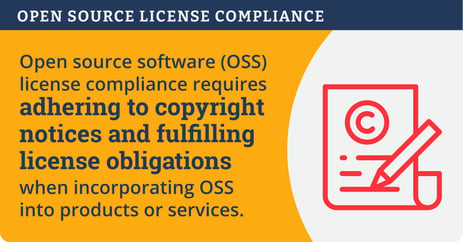
- Compliance with OSS licenses is a multifaceted process that begins with identifying all OSS integrated into a product or service. This necessitates a meticulous plan to fulfill the myriad of license obligations associated with each component. The complexity intensifies as organizations grapple with the diverse licensing landscape and the dynamic nature of software development.
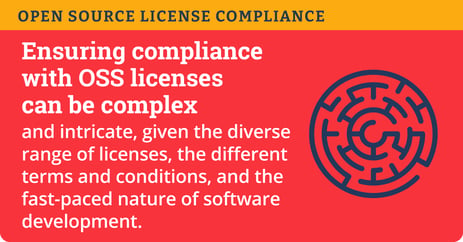
- To effectively manage OSS license compliance, organizations need robust tools. An advanced Software Composition Analysis (SCA) tool proves indispensable in this regard. These tools boast comprehensive features, aiding organizations in accurately identifying incorporated OSS, understanding licensing requirements, and ensuring adherence to obligations.
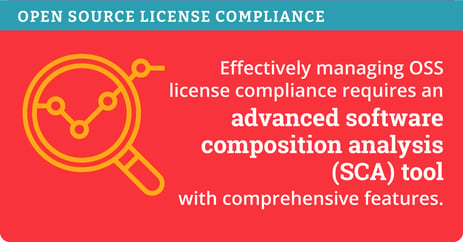
- Promoting a culture of openness and accountability is key. Beyond tools, organizations can instill a culture of openness, accountability, and collaboration by providing users with visibility into their compliance processes. This transparency not only fosters a sense of responsibility but also enables the organization to address compliance issues or inquiries efficiently.
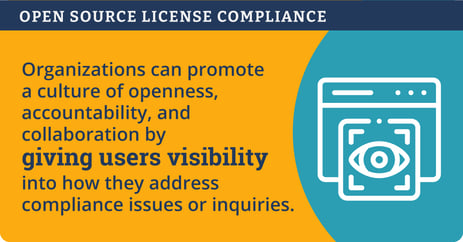
- Organizations can be proactive by integrating compliance into the development process itself. By doing so, organizations reduce the risk of non-compliance while cultivating a healthy internal open source governance culture. This proactive stance ensures that compliance is not an afterthought but an integral part of the software development lifecycle.
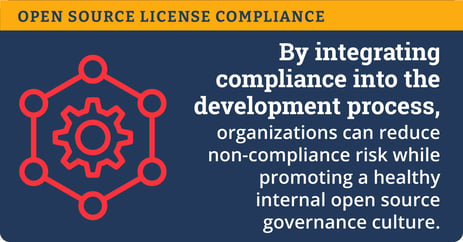
- Managing OSS license compliance at scale requires leveraging appropriate tools and garnering internal support. This strategic combination helps in mitigating compliance risks and ensures that adherence to license obligations becomes an integral aspect of the development workflow.
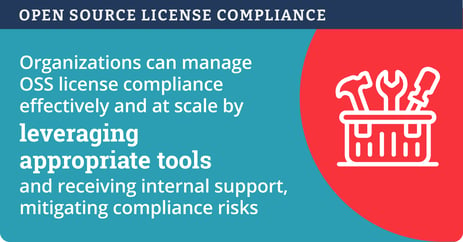
- The efficacy of SCA tools hinges on their accuracy, consistency, and integration. These tools must navigate complexities, identify all OSS components, and stay updated with the ever-evolving OSS licensing landscape. Achieving this balance is critical for organizations relying on SCA tools to facilitate compliance. To maximize their effectiveness, these tools must seamlessly integrate with the software development lifecycle, which requires automating the scanning of code for open source components and licensing requirements. The integration ensures that compliance is an inherent part of the development process.
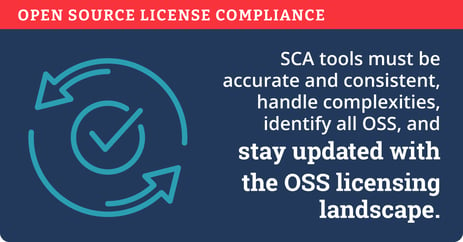
- Another important tool for compliance is the Software Bill of Materials (SBOM). The adoption of SBOMs is increasing as a means of providing transparency into a software product or service. SBOMs offer insight into component usage, open source licenses, and potential vulnerabilities in the open source components in use, and when standardized in a common format – such as the Linux Foundation’s SPDX project – reduce the workload of collating this information. Despite these advantages, challenges arise when origin and license information of the AI system’s source code is absent, hindering downstream users from generating accurate SBOMs. This gap raises a critical concern, as the inability to trace security vulnerabilities poses a significant red flag in maintaining comprehensive cybersecurity measures.
- Auditability is a central challenge for organizations aiming to maintain transparent and comprehensive audit trails of all OSS and license compliance-related activities. The ability to demonstrate adherence to license obligations becomes paramount, especially in the face of
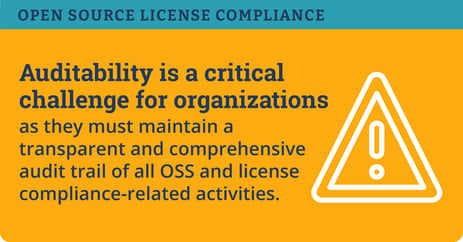
- The rise of artificial intelligence (AI)-generated code introduces new challenges to the compliance landscape. Organizations can initially address these challenges by implementing policy options and providing guidance to developers. As AI becomes more prevalent, refining compliance strategies for AI-generated code will be imperative.
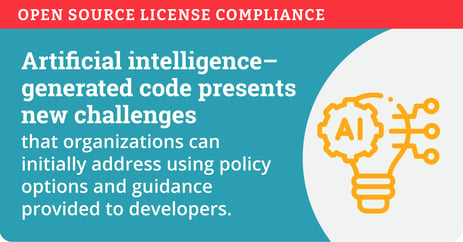
- As the prevalence of OSS continues to grow, establishing a robust and automated compliance process becomes critical. This not only safeguards organizations from legal repercussions but also shields them from reputational risks associated with non-compliance.
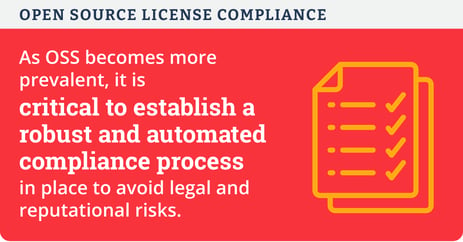
Software developers and business leaders stand to gain invaluable insights from the report, Open Source License Compliance: Challenges Ahead. It offers a comprehensive roadmap, emphasizing the complexities of compliance and the need for advanced Software Composition Analysis (SCA) tools, SBOMs, and integrating compliance into the development process. Following this roadmap reduces non-compliance risks and helps foster a culture of transparency and collaboration.
Moreover, the report tackles emerging challenges, including those posed by artificial intelligence-generated code, and advocates for robust, automated compliance processes. By delving into the intricacies of OSS license compliance, this report equips professionals with the knowledge to harness the benefits of open source innovation confidently while safeguarding against legal and reputational risks. It serves as an indispensable guide, ensuring that both developers and business leaders are well-prepared to navigate the complex terrain of open source software integration.